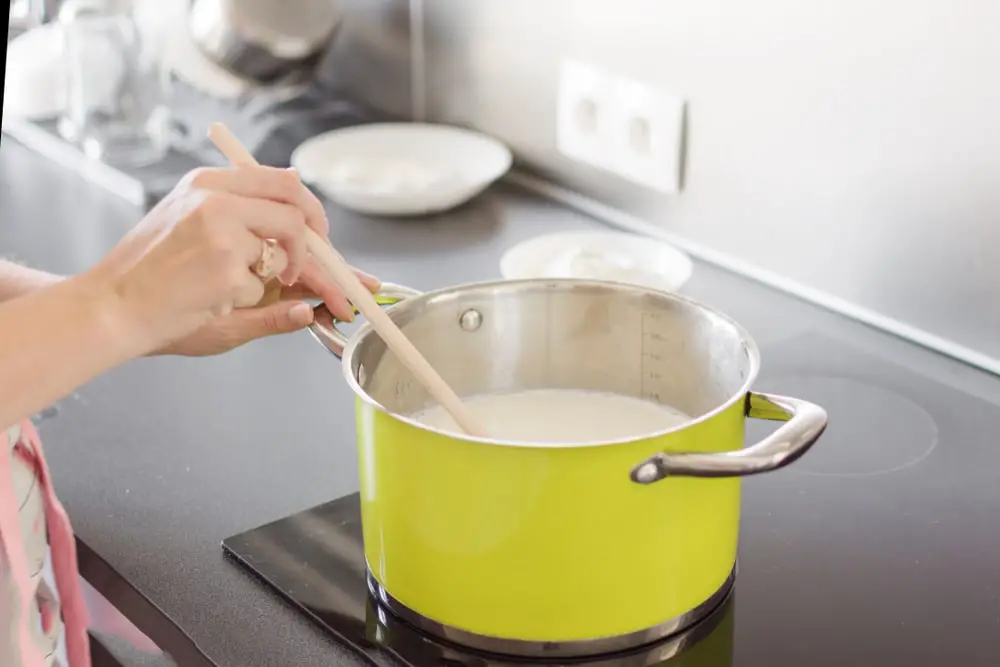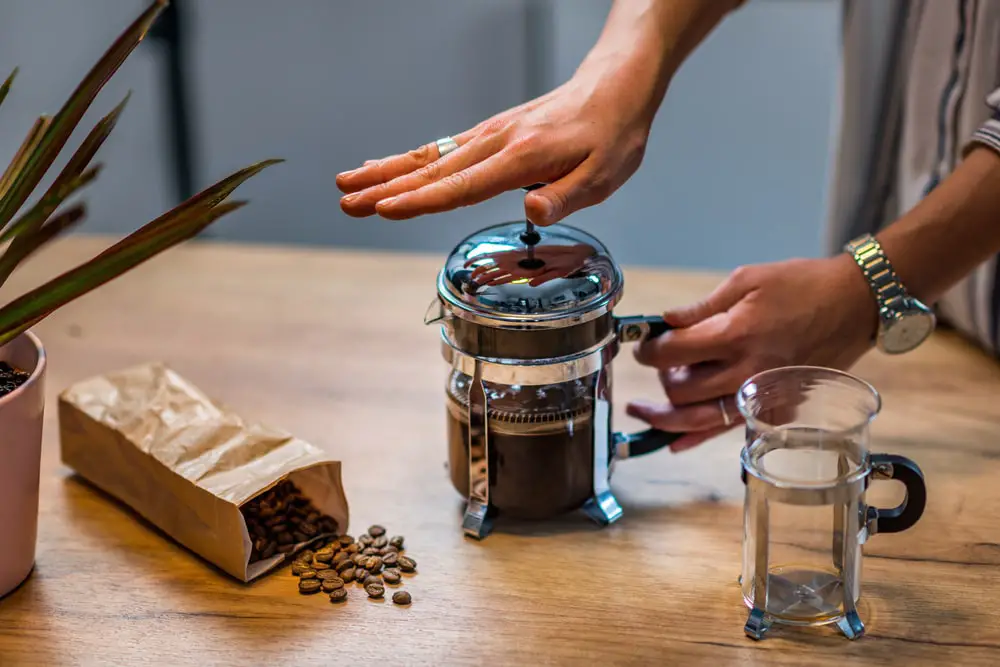Milk, an enormously popular addition to reduce coffee’s bitterness and give it a creamy texture, will no stranger to every barista or coffee enthusiast. However, only after the coffee has been made will you witness individuals pouring milk into it. Have you ever considered brewing coffee out of milk rather than water? Although it may appear suspicious and impossible, numerous individuals have successfully brewed coffee using milk.
So, can you brew coffee with milk? What should you keep in mind when conducting this method? Let’s get started answering these questions with the help of this article.
Is Coffee Brewed With Milk Possible?

Coffee is a rich beverage with a bitter and sour flavor, but milk provides thick fats and sugars that help to offset the bitterness of coffee. This combination will help make the drink smoother and milder for individuals who have a sensitive stomach or are intoxicated by coffee.
Most notably, it is totally okay to brew coffee using milk rather than water though I recommend that you do it sparingly and carefully consult the recipe and procedure guidelines. This is because brewing coffee with milk will result in a lighter cup of coffee and may create issues such as curdling and clogging of your coffee maker.
How To Brew Coffee With Milk?
When it comes to making coffee with milk, there are a variety of ways and devices that may be used at home. Drip machines, single-cup dispensers, and pour-over coffee makers are common varieties that customers desire to utilize. Unfortunately, I do not endorse these combinations.
Using a coffee machine to brew coffee with milk causes a slew of unexpected issues. This is because the calcium in milk can cause calcium deposits to build in the machine, clogging the water reservoir and causing long-term harm. If you’ve ever had hard water issues, calcium is usually the root cause, thus even washing the machine with water afterward might lead to problems and impair the next coffee preparation.
Furthermore, if you utilize the pour-over technique, poor filtering might cause your milk to jam or take a lengthy time to process. I guess this won’t be the most delectable and satisfying cup of coffee you’ve ever had, right? You may also make cowboy coffee and filter it through a strainer, but this will need thorough filtering and result in gritty coffee.
All things considered, many people choose to adopt a French press to prepare coffee with milk rather than water. This isn’t the only option, but it’s the most straightforward and secure. It’s worth noting that utilizing the French press still necessitates caution and an understanding of the differences between water and milk. To prevent the difficulties outlined above while brewing coffee with milk, make sure to completely clean the French press once you’ve finished.
Instructions And Notes To Bear In Mind When Brewing Coffee With Milk Using A French Press
Making coffee with milk instead of water is worth giving a try at least once, but there are certain fundamental guidelines and processes to follow in order to avoid ruining this specific cup of coffee. The following are the basic procedures for preparing coffee with milk:
Heat The Milk

The majority of individuals who learn and use coffee for a long time think that the ideal temperature for brewing coffee is between 190 and 205 degrees F. Although many people choose milk when brewing coffee since it might help to lessen the acidity of coffee, it is easy to burn and coagulate with coffee and extra sweetness due to the sugar and fat contained. This is the first challenge when you prepare to brew 1 cup of coffee with milk instead of water.
Fortunately, there is yet hope for resolving the issue. You’ll have two options for getting the milk to the right temperature without boiling or scorching it. The first way to keep the milk from curling is to microwave it for 20-40 seconds (I prefer pyrex). Remember to take it out and whisk every 20-40 seconds until it reaches the right temperature. The second method is to cook it in a pot over low heat with regular stirring.
In any case, you’ll be able to heat the milk gently and evenly to avoid disrupting or deforming the milk’s components and causing clumping in your coffee.
Start Brewing Some Coffee

Making the coffee after heating milk might also be a difficulty because the heated milk appears to cool down more rapidly than it would with water. As a result, the adoption of a French press is the most optimal technique suggested.
In particular, pour the milk into a French press once it has been heated to the proper temperature. It takes roughly 4 minutes for the coffee to soak in the French press on average. Since the milk will chill fast, you can increase the number of coffee grounds and prepare it a bit sooner compared to the normal period of time.
Furthermore, you’d better make only enough coffee for one drink and enjoy it quickly as coffee brewed with milk has a shorter shelf life than that with water.
How Much Coffee Should You Use?
Milk and water are not the same so you may not be able to obtain the ideal flavor by using the same amount of ground coffee as you would typically brew. Furthermore, milk comes in a variety of types with different fat content. As a result, choosing and measuring the number of coffee grounds to use can be a difficult operation that takes a few tries to get right.
As previously mentioned, milk has the power to erase many coffee properties as well as bitter and sour qualities from the drink, you should use dark or even roasted coffee or twice the number of coffee grounds you normally use if you want a strong coffee. In case you are sensitive to caffeine, proceed with caution. In my experience, it’s better to select a darker roast, which gives the coffee more taste while also containing less caffeine (light roast has more caffeine than dark roast).
A Few Additional Methods To Brew Coffee With Milk
Cold Brew
Cold brew is a great method to try out the combination between coffee and milk. The coffee should be medium to dark roasted in this case to guarantee that some of the coffee’s flavor is retained when brewing with milk. Add raw ground coffee in a 1:4 ratio of coffee to milk. It’s ideal to use a masonry jar since they’re easy to clean and the coffee may be added directly from the blender or a bag if you prefer.
Refrigerate the coffee for 12 to 18 hours before straining it through cheesecloth or something similar. Cold-brew coffee can be consumed straight up, over ice, or combined with vanilla ice cream to make a condensed latte.
Brewing Instant Coffee With Milk
In another way, although instant coffee may not appeal to many coffee connoisseurs, it is a simpler way to prepare coffee with milk. This is really simple since you can mildly heat the milk in a cup and then pour instant coffee in. In this way, you can exactly manage both the flavor and caffeine content by monitoring the milk output, and of course, cleaning up will be much easier.
Final Thought
Making coffee with milk seems to be a one-of-a-kind technique, but there are some drawbacks in terms of the coffee’s flavor and a lot of attention during the brewing process. However, isn’t this something you should attempt once in your lifetime if you’re a coffee lover? Try it out and see if the results are satisfactory; best of luck to you.
